In my final post from my recent trip to India I’ll take you to a strange utopian township with a huge gold plated meditation chamber that houses one of the worlds largest crystal balls, share a beautiful sunrise over the Bay of Bengal, show you spectacular monuments carved in gigantic hillside rocks, and reveal how burning dead people smell just like burgers on a grill!
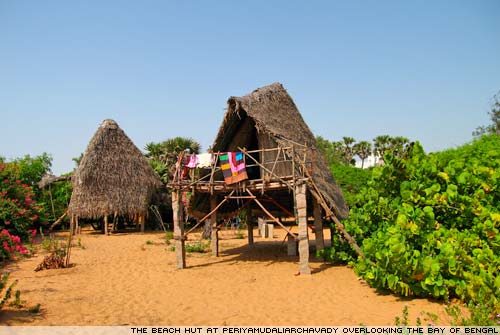
 Not far from the former French colonial city of Puducherry (Pondicherry), which felt a little like an Indian version of New Orleans, lies Auroville – a self styled ‘universal town’ founded way back in 1968 by an idealist by the name of Mirra Alfassa. Referred to by the townspeople as ‘The Mother,’ Alfassa envisioned Auroville to be “a universal town where men and women of all countries are able to live in peace and progressive harmony above all creeds, all politics and all nationalities” She died in 1973 but her vision of Auroville continues today.
Not far from the former French colonial city of Puducherry (Pondicherry), which felt a little like an Indian version of New Orleans, lies Auroville – a self styled ‘universal town’ founded way back in 1968 by an idealist by the name of Mirra Alfassa. Referred to by the townspeople as ‘The Mother,’ Alfassa envisioned Auroville to be “a universal town where men and women of all countries are able to live in peace and progressive harmony above all creeds, all politics and all nationalities” She died in 1973 but her vision of Auroville continues today.
Joelle and I rented a beach hut that looked out across to the warm and perilous waters of Bay of Bengal. Next to the village of Periya Mudaliarchavady the small collection of beach huts play host to an ever changing stream of travelers from around the world. Though simple, the accommodation is well worth the 300 Rupee a night price tag (that’s about $7/£3.50).
Not known as a person who gets up early in the morning, I surprised even myself as I awoke each day to the sound of the surf as the sun began to peer over the horizon to the east. I’d stand at the entrance to the hut and almost have to pinch myself. “That’s the bay of Bengal” I’d tell myself, as if I needed reminding.
For breakfast guests would sit at what I called “the international breakfast table” and eat home made muesli and backed goods while exchanging stories of their various travel adventures. I enjoy these moments of random convergence with people I know I’m unlikely to meet again because there’s something about the crossing of paths that I love. It’s like watching the intricate tapestry of life being thread right before your very eyes as the various paths intertwine for those brief and random moments.
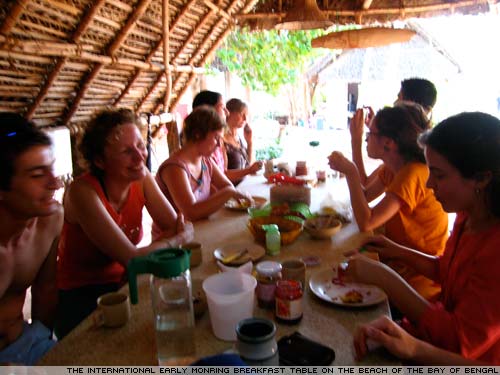
Two people that we spent a little time with were Pricilla from Venezuela and Hugo from Argentina. I’d met Hugo a few days earlier at a dinner party at Laxman’s house, and struck up a conversation with Priscialla early on the beach one morning in an effort to find out if she was Russian as Joelle seemed to be under the impression that all white people we saw were Russian by default.
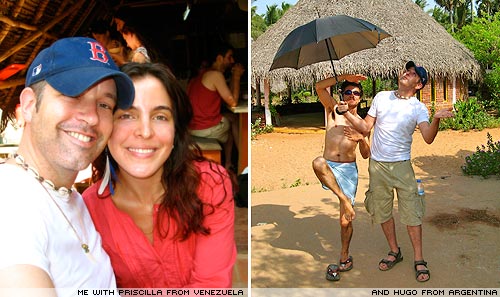
Away from the beach huts Auroville itself feels like a moment of clarity in a mind of madness. It’s a strange place set apart from it’s surroundings. It might be cruel to describe the township as a big budget hippy commune, but that’s the overall impression I got. Make no mistake though, I’m not being critical, the utopian ideas behind Auroville are admirable, but such ideas seem a little out of step with the world we live in and somewhat cumbersome in their implementation.
For example, residents don’t use money in the form of notes or coins, but instead they use a centralized monetary system connected directly with their bank accounts. This might work for them, but visitors have no choice but to use cash, and the township has little choice but to accept this in most places.
 Back in 1968 Auroville was just an Indian wasteland, but thanks to the work of volunteers funded by donations and grants from the Indian government the landscape was transformed into the lush green forest it is today. However, there is a palpable divide between the Aurovillian settlers (mostly European) and the local Tamil people who live in the very different conditions to their neighbors.
Back in 1968 Auroville was just an Indian wasteland, but thanks to the work of volunteers funded by donations and grants from the Indian government the landscape was transformed into the lush green forest it is today. However, there is a palpable divide between the Aurovillian settlers (mostly European) and the local Tamil people who live in the very different conditions to their neighbors.
I couldn’t help but wonder if life in Auroville is reflective of what India might have felt like when it was under Imperial British rule, and given the stark differences between the traditional Tamil villagers lives and those of the settlers, I wondered if that might perhaps lead to tension. On the plus side though, Auroville does provide schooling and employment for the local Tamil people and the township was instrumental in the recovery efforts after the devastating tsunami in 2004.
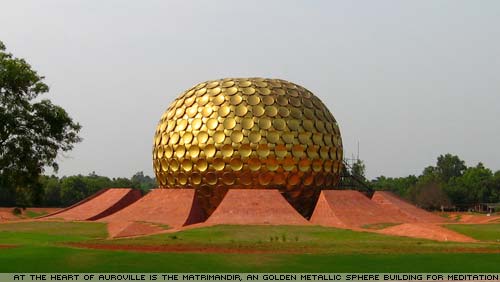
At the heart of Auroville is huge spherical structure called the Matrimandir. Covered by golden discs and built in such a way as it appears to be coming out of the ground the Matrimandir is an awe inspiring building that shares its place in the centre of the township with an equally impressive sprawling banyan tree.
The Matrimandir is not supposed to be a temple per se, in that it doesn’t belong to any particular religion or sect. The buildings purpose is to be a place of meditation. Visitors are welcome, however it’s not simply a question of turning up and walking around the golden golfball. Instead visitors have to book an induction appointment whereupon they are taught the history of Auroville and the Matrimandir before being allowed to enter the building for an initial period of 15 minutes.
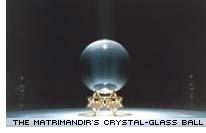 Entering the building, which has only this month been completed after building work began back in 1971, is like entering any holy monument, albeit with a twist of Arthur C. Clarke science fiction to it. Absolute silence is observed at all times and everything inside the building is white, including the marble walls and the socks each visitor has to wear in order to preserve the pristine white carpet.
Entering the building, which has only this month been completed after building work began back in 1971, is like entering any holy monument, albeit with a twist of Arthur C. Clarke science fiction to it. Absolute silence is observed at all times and everything inside the building is white, including the marble walls and the socks each visitor has to wear in order to preserve the pristine white carpet.
In the initial 15 minute induction visitors are lead to the ‘Inner Chamber’ in the upper hemisphere of the structure. The large room is dimly lit by a single beam of sunlight directed through an opening at the apex of the sphere to a large pure crystal-glass ball in the centre of the room. There are no images or religious forms, just a white carpets, cushions, pillars, and total silence. Everyone sits down and then for the next 15 minutes you are supposed to meditate or contemplate.
You can put it down to ADD or something, but I’m not much of a sit there crossed legged and meditate kind of a guy. For the sake of the experience I did do about three minutes of that, but then I opened my eyes and spent the rest of the time watching the other people some of whom were clearly very meditative folk, others of whom were clearly just tourists intent on seeing inside the golden golfball, just as I was.

I feel like my experience barely scratched the surface of Auroville, but can’t write about my stay there without mentioning the strange experience of returning to the beach one night to be greeted by the smell of cooking meat and the sight of a burning dead body beside our hut.
The beach hut location also happens to be a funeral ground for local villagers. While we were away having dinner there had been a funeral, and as per Hindu tradition the body of the deceased was burned on a funeral pyre which just happened to be next to our beach hut.
It felt a little strange, almost wrong, to stand there in silence and watch the body of a person sizzle and burn. But this was just another stark reminder of how very different our cultures are. As Joelle and I stood there and watched the flames burn what had once been a person, far from being something of a creepy experience, I found myself feeling challenged about death and how our culture faces that inescapable reality with almost clinical disassociation.
By the morning there was nothing left of the pyre but ashes, and shortly after sunrise the men of the funeral party returned with clanging drums and bells to collect them.

The next stop was a place called Mahabalipuram (also known as Mamallapuram), a city full of spectacular carved monuments built between the 7th and the 9th century. Full of Buddhist as well as obvious Hindu influences, a number of the carvings that are amazingly cut into the bare rock face, are believed to have been the work of sculptors who were perhaps learning the craft or maybe demonstrating examples of different styles of architecture.
My last day in India was spent in Chennai (Madras), where the now familiar noise of the city streets mixed with the chanting call to prayer being bellowed into the thick air from loud speakers atop of the towers of local mosques. India, it would seem, did not want me to leave without my ears still ringing with the sound of this beautifully chaotic nation.
As the sun sank behind the rooftops, Joelle took me to Chennai beach for one final and unmistakably Indian experience. In the west a vast beach such as this, with its bath warm water, would almost certainly be strewn with the near naked bodies of sun seekers determined to take advantage of every last ray of light. But this is India, and nowhere is there a bikini or a sunbather. The men are wearing button up shirts, ironed slacks and shoes that would not look out of place in an office. The women are in sari’s and many are in traditional Islamic clothing. The waters edge is teeming with fully clothed people wading barefoot to feel the rush of the surf between their toes, the collective shrieks of their excitement dance and fade with the sound of the waves in the warm salty sea air.
After dinner I pack my bags for the final time and sit with Joelle on the roof of the Broadlands Lodging House that looks out over the rooftops of the city and across to a large mosque. In just a matter of hours I’ll be on a plane back home, and for that reason I’m in no hurry to go to bed.
Tomorrow will come in its own time, but for now I want to sit here and savour what remains of this final night under an Indian sky.
—
Auroville in controversy
Local concerns over Indian utopia
Frugal Traveler; In India, a low-budget journey frees the spirit
(Special thanks to Joelle and Laxman for their generosity and hospitality without which this adventure would never have happened.)


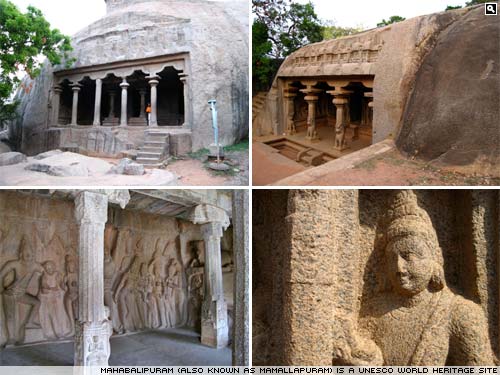
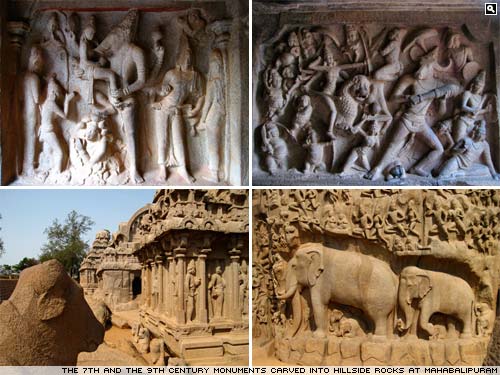
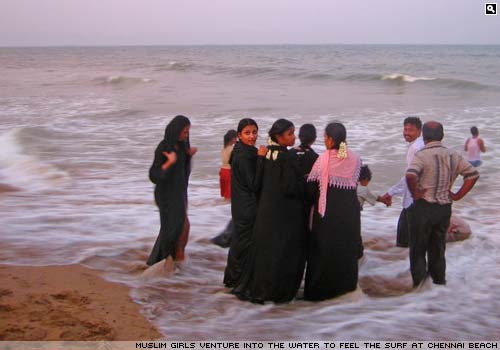


Wrote the following comment on May 29, 2008 at 2:49 pm
How strange, I’d never heard of Auroville until the other night when I saw a (not very flattering) report about it on Newsnight.
How did the people at the funeral feel about you taking a picture of the burning body? Oh and those carvings are amazing too!
I’ve really enjoyed these posts. Reading them has given me itchy feet! I need an adventure of my own now. Thanks Simon!
Wrote the following comment on May 30, 2008 at 8:57 am
That’s a nice post, Simon, and good too. (ie, not cheesy ;-). Thank you.
As you know, I’m back home, and right now, second morning of waking up too early, I feel lost. It’s so silent, and there seems to be nobody there.
India, Asia, has this way to grab you somewhere, somehow.
Wrote the following comment on May 30, 2008 at 12:31 pm
Welcome home Joelle. If you look on your doorstep you’ll see a little plant pot with a gift in it :-)
Bella, I’m glad you enjoyed the posts from India. There weren’t actually any people at the funeral pyre when we were there. They stay around for the lighting and then eventually leave. The men then return at sunrise to collect the ashes.
Wrote the following comment on May 30, 2008 at 6:26 pm
i’d totally love to meditate inside that golden golfball. your trip sounds exquisite!
Wrote the following comment on May 30, 2008 at 7:24 pm
Good ending to a good trip. The ball interests me. I’ll have to do some googling around to find out who created it and why. I think it would be a very interesting perspective on the world that would come up with something like that.
Wrote the following comment on May 31, 2008 at 2:18 am
After the week I’ve had I look at this picture of that beach hut and think to myself that looks like somewhere I would like to be right about now, and at $7 a night, even better!
Wrote the following comment on May 31, 2008 at 4:28 pm
So, here is an idea. Since you are a natural documentarian, find some investors and return to Auroville and take the leap into film.
The angle you could take is how the place represents a sort of naive hippy idealism that is yet expressive of genuine human spiritual aspirations. You could do some further investigative work to find out if there is any genuine tensions between the the Tamil locals and the relatively more prosperous Auroville settlers. From this you could focus on the irony that often our highest aspirations are matched by a pretty profound shadow side, which is indicative of the central tension of being human.
Just a thought.
Wrote the following comment on Jun 1, 2008 at 10:24 am
That would be a big project to chew on Anthony.
Wrote the following comment on Jun 1, 2008 at 12:15 pm
Beautiful photography of places close to my heart.
Wrote the following comment on Jun 6, 2008 at 6:02 am
I went to Mahabalipuram a couple of years ago but I could never say “Mahabalipuram” so I just took to calling it “ramalamadingdong.” Surprisingly everyone knew exactly what I was talking about!
Wrote the following comment on Jun 9, 2008 at 7:04 pm
So they finally finished that thing!! When I was there (’76) the Orb was in the very early stages and completion seemed a long way away.
Wrote the following comment on Jun 19, 2008 at 5:06 am
Hey I am from India and have always heard about “India being good” as a vague description from westerners, this is really the first time someone has been able to include the variations of South India so beautifully! Kudos to you and keep trekking!
Wrote the following comment on Jun 19, 2008 at 12:39 pm
Thanks Rajul. And don’t you worry, I’ll indeed keep trekking! :-)